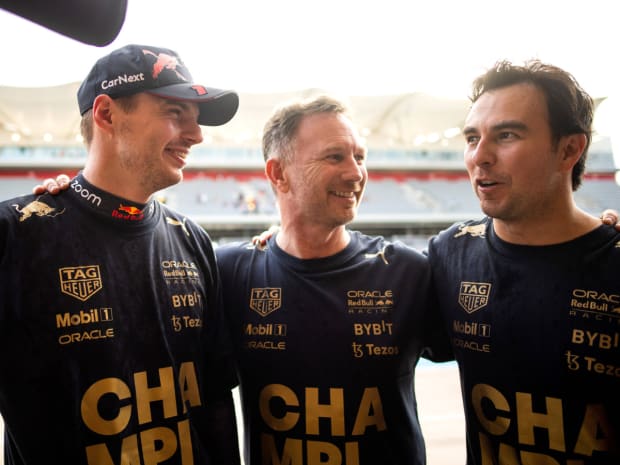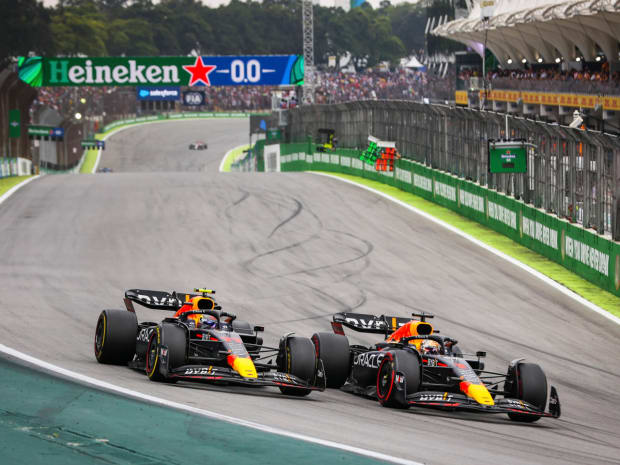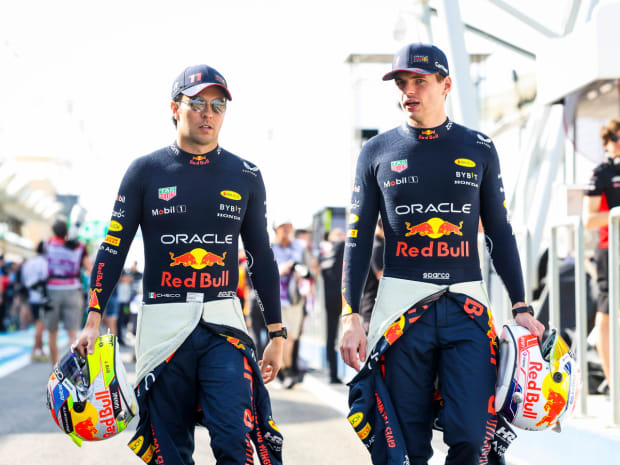A still white frost and gentle fog settled on Milton Keynes one Sunday morning in December, silencing the bustling English town and sharply contrasting the events of the day before. Tucked in Buckinghamshire just north of London, the vibrant community is known for its concrete cow sculptures, vast greenery and sometimes chaotic roundabouts. Some are the one-lane format that Americans are used to, while others are multilaned with cars zipping in and out at speeds that would shock a visitor.
Especially if the cars are the RB7, the model that won the Formula One drivers’ and constructors’ championships for Red Bull in 2011.
That chilly morning, Midsummer Boulevard, located in the heart of Red Bull Racing’s home city, was shut down to celebrate the team’s 2022 titles. Thousands of fans gathered to watch drivers Max Verstappen and Sergio Pérez fly down the street and through a roundabout. One person’s reaction captured why fans squished together on the street and rubbed their hands together to find some semblance of warmth.
Geri Halliwell-Horner, perhaps more famously known as Ginger Spice and the wife of team principal Christian Horner, slid into Pérez’s car. “A bit lower, darling,” he told her when she tried to sit like one would drive an average car. Practically lying down, she looked at Horner, the excitement evident. “What’s the speed?” she asked, to which he responded, “250 miles an hour.”
“Two hundred and fifty miles an hour! You are a gladiator. Oh my God,” Halliwell-Horner gasped, echoing what many spectators likely think as they see an F1 car zoom past. But what is dangerous to her is business as usual for an F1 driver. While combating heat, g-forces and dehydration, athletes also have to remember various strategies and code words. All for a chance to be sprayed with champagne on the podium.
For Red Bull last season, the champagne flowed at a historic rate. The team ran away with the constructors’ championship, picking up 17 wins, 28 podium finishes and 759 points. Verstappen made history with 15 of those victories en route to his second drivers’ title. But the season also featured controversy and drama—some of which could seep over into 2023—including the loss of much of the team’s heart, the visionary who instilled in the team its think-outside-the-box culture.
After the most dominant season in history, the gladiator is going to have to fight to stay on top.
“You’ve just got to stay focused on what your goals are,” Horner says. “The thing that we all have in common in the team is the car, and that’s the thing that unifies everybody.”
News of Red Bull owner Dietrich Mateschitz’s death broke before Saturday qualifying at the U.S. Grand Prix in Austin last October. On race day, the Rolling Stones blared from the Red Bull garage—not an atypical selection in the paddock, but definitely louder than usual. The musical choice and the team’s decision to wear jeans—the preferred attire of the multibillionaire—were two ways they honored the one who started it all.
Mateschitz founded the energy drink company in the 1980s with a partner before branching out into racing. He partnered with the Sauber team in ’95, and, in 2004 the Austrian bought Jaguar and rebranded it as Red Bull Racing. The following year he bought the Minardi team, which has now become AlphaTauri, Red Bull’s sister team. Mateschitz played a pivotal role in the careers of eight of the 20 men who drove in F1 last year. But his influence extended beyond them, as he grew Red Bull into an adventure sports juggernaut and gave plenty of athletes, engineers, technicians and other employees a chance in motor sports, hockey, soccer, esports (and supersonic parachuting from outer space).

IMAGO/Eibner
One of those people was Horner, who became the youngest F1 team principal in 2005, at 31. Horner had risen through the ranks as a racer, but, by 25, he had transitioned into a managerial role for the team he and his father, Garry, created, leading Arden International to three Formula 3000 team titles. That caught the attention of Red Bull team adviser Helmut Marko, who introduced Horner to Mateschitz and told the owner to “take a risk.”
Horner’s mindset fit in perfectly in his new home: “It was all about winning the hearts and minds of the people.” He and Red Bull won four consecutive constructors’ titles from 2010 to ’13, then found themselves in a slump. When F1 overhauled its engine regulations in ’14, Red Bull’s supplier, Renault, delivered what Horner called an inferior product, leaving the team to play catch up. Last season also featured significant rules changes, but not in the engine, putting the onus on Red Bull’s engineers. “We were in control of our own destiny,” says Horner.
The car they developed, the RB18, would become one of the most dominant in history—especially as the team was able to shave weight from it as the season wore on. On top of that, the crew outfoxed the rest of the grid at times, such as when Verstappen won the Hungarian Grand Prix after starting 10th thanks to a canny tire strategy.
And then there are the drivers. Though they come from different backgrounds, Verstappen and Pérez form the balanced dynamic that most teams dream of, the former being more aggressive while the latter is more conservative and stellar in tire management.
Verstappen went down in F1 history in 2022 after recording the most points and the most wins in a single campaign. Horner describes the 25-year-old as “probably the most talented driver of his generation. His mental strength is something I’ve not seen in a driver before. . . . Almost the more pressure [there is], the more he delivers.”
The Dutchman comes from a racing family. Verstappen’s mother, Sophie Kumpen, was a kart racer, and his father, Jos Verstappen, drove in F1. Jos was heavily involved in Max’s career, and his strict training methods—he once left Max at a gas station after a subpar performance in a kart race—have drawn criticism. “We had a very honest, strong relationship, but also, I think, if we would have had a camera on us from 7 until 15, a lot of people will be shocked, because my dad could be very hard on me,” Max says. But, he adds: “I also knew that I needed that.
“If I wouldn’t have had that kind of preparation and mentorship, I wouldn’t be sitting here today, so I’m very happy that I had it. And it also prepares you so well for Formula One, because once you arrive in Formula One, honestly nothing will ever come close to how I grew up, in terms of toughness. They will say Formula One is very tough. Well, I think my early years of racing were way harder than what I’m experiencing now.”
While Verstappen was groomed for F1 from childhood, Pérez was content to stay in Mexico. But after an incident in a kart race where he got tangled up with an older—and influential—driver, the Mexican racing federation pulled the Guadalajara native’s license.

IMAGO / HochZwei
So Pérez chased down possible teams through faxes and cold calls, then moved to Europe. He finally made it to F1 in 2011, competing for four other teams before landing with Red Bull in ’21, when he became just the second driver to sign with the team without going through its driver academy. “It’s a top team [with] big ambitions every year, and it’s all about winning here,” says the 33-year-old. “And that’s really enjoyable, to be honest.”
In his first season with Red Bull, Pérez won in his sixth start—the team’s first win by a driver other than Verstappen in three years—and played a pivotal role in helping his teammate win his first world championship. He became known as the Minister of Defense (a nickname coined by Verstappen) after blocking Lewis Hamilton in the season finale in Abu Dhabi, where Verstappen clinched the title on the last lap. In 2022, Pérez won twice more, including the Monaco Grand Prix, to become the most successful Mexican F1 driver in history. “He’s addressed that it’s not easy for him being a teammate to a driver of someone like Max,” Horner says. “And he’s coped with that well, because, again, mentally that’s incredibly tough when you’re having to go up against a competitor that is as strong as he is.”
Back in Milton Keynes in December, Verstappen’s and Pérez’s laughter echoed in Red Bull’s race bay. They were miked up, with Netflix filming them for Drive to Survive and a boom operator hovering just out of the camera’s view. Their geniality showed no hint of what had gone down in Brazil just weeks earlier.
During the São Paulo Grand Prix, Verstappen, with the title already clinched, refused the team’s instructions to let Pérez, who was competing for second in the drivers’ championship, pass him on the last lap. The Dutchman would only allude to an earlier conversation between them as his reason. That moment triggered an onslaught of online abuse, so much so that Verstappen revealed his parents, sister and girlfriend were also receiving hateful comments. “You can be angry at me, but do not go after my family,” says Verstappen. He says he’s not bothered by the hate being sent his way, because it’s based on brief on-camera moments and snippets heard over the radio. “I don’t want to say the whole story, and I can’t, and I will not,” he says. “I stand by that, and it’s fine. Within the team, we have a great relationship, and, at the end of the day, that’s what counts.”
But Brazil was not the only controversy the team endured in 2022. During the Singapore Grand Prix weekend in October, rumors began circulating that two teams, including Red Bull, had exceeded the ’21 season cost cap. The sport’s governing body, the FIA, had yet to complete its analysis of all 10 team’s budgets, but that didn’t stop the noise. “If that was a trial, you’d have to change the jury, because all this leakage and propaganda that was being fueled was extremely upsetting when we hadn’t even had the facts . . . from the FIA,” Horner says. “It felt like a trial by media before we even knew what the charge was.”

IMAGO/HochZwei
The following Sunday, Verstappen clinched the title, and a day later the FIA announced that Red Bull had committed a procedural breach. Horner’s team was found to have exceeded the cap by 1.6% (but if a tax credit had been applied properly, the breach would have been by 0.37%—or roughly $400,000).
When F1 arrived in Austin two weeks later, a punishment still had not been handed down. One rival team, McLaren, sent a letter to the FIA asserting that any breach constituted “cheating,” and, Horner says, some employees’ kids were being bullied over the controversy. Finally an agreement was reached; the punishment was a $7 million fine and a 10% cut in aerodynamic testing time for 12 months. That’s on top of the reduction in testing time that comes with winning the constructors’ title. “[It will] have a material effect on our performance,” Horner says, estimating it could cost his team between a quarter- and a half-second per lap.
Still, the team is looking ahead as it prepares to defend its dual titles in 2023. “Winning is addictive,” Horner says. “The fear of failure is what drives us on as an organization.” And they’re looking past this year, as well. With massive rules changes coming in ’26 (including increased electrical power and 100% sustainable fuels), the engines will be built by Red Bull Powertrains, in a partnership with Ford. “When [current engine partner] Honda announced their withdrawal from Formula One, it was a litmus moment where we had that choice of, do we accept being a customer and accept being second-best?” Horner says. “Or do we actually take control of our future and design and manufacture and operate our own power unit?”
Within just over a year, the facility had been built, and the engine was designed and running on a dyno. “As a subsidiary of an energy drinks company, to be taking on manufacturers and teams and historic brands, that sometimes doesn’t sit particularly comfortably, that we are a project of the larger business,” Horner says. “The higher you rise, the sharper the knives, and that’s no truer than in Formula One.”






